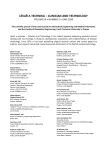THE EFFECT OF FOOTWEAR TO THE POSTURE
Autoři:
Marianna Trebuňová; Mária Danko; Lucia Bednarčíková; Monika Michalíková; Jozef Živčák
Působiště autorů:
Department of Biomedical Engineering and Measurement, Faculty of Mechanical Engineering, Technical University of Kosice, Kosice, Slovakia
Vyšlo v časopise:
Lékař a technika - Clinician and Technology No. 2, 2020, 50, 58-64
Kategorie:
Původní práce
doi:
https://doi.org/10.14311/CTJ.2020.2.03
Souhrn
The aim of this study is to assess the effect of footwear on postural status of a group of volunteers representing the general population of female students. Based on the assumption that the elegant shoe with tapered toe and high heel does not provide adequate foot support, the study was designed to assess its direct link and impact to body segment alignment and resulting negative effect on posture. Repetition of this misalignment ensures the individual circumstances of posture. Due to the heel elevation, the weight is transferred to the distal part, resulting in a postural response of the entire musculoskeletal system to maintain balance. The group consisted of 30 women of the age 18–28 years with an average age of 22.7 years, height 167±0.3 cm and weight 57±0.9 kg. Anamnesis and aspection were performed to assess of the occurrence of shortened and weakened muscles and subsequently the patient's standing was examined. Two static methods were chosen for evaluation of the posture. The first one was the Silhouette Posture Analysis and the evaluation method by Jaros and Lomnicka. The result was the identification of typical muscle imbalance as the most common presumption of faulty posture, and it was confirmed that footwear affects a person's natural posture. Differences in the sensitivity of the two methods were also identified and studies are not only appropriate that but also evaluate differences in impact among subjects.
Klíčová slova:
high heels – flat shoes – postural stability – posture – posturology – Silhouette Posture Analysis
Zdroje
- Stolinski L, Kozinoga M, Czaprowski D, Tyrakowski M, Cerny P, Suzuki N, et al. Two-dimensional digital photography for child body posture evaluation: Standardized technique, reliable parameters and normative data for age 7-10 years. Scoliosis and Spinal Disord. BioMed Central Ltd. 2017;12:1–24.
- Molnárová M: Posture, its meaning, diagnostics and disorders. Rehabilitacia [Internet]. 2009 Dec [cited 2020 Jun 15]; 46(4):195–206. Available from: https://www.rehabilitacia.sk/archiv/cisla/4REH2009-m.pdf
- Pernicová H, Bělková-Preislerová T, Javůrek J, Kyralová M, Labudová J, Strnad P. Zdravotní tělesná výchova. Praha: Fortuna; 1992. 184 p.
- Matascikova S. Vplyv obuvi na posturu [bachelor's thesis]. Košice: TUKE; 2017.
- Quin E, Rafferty S, Tomlinson C. Safe Dance Practice, Human Kinetics. Australia: Human Kinetics Australia P/L; 2015.
- Kubat O, Ovadia D. Frontal and sagittal imbalance in patients with adolescent idiopathic deformity. Ann Transl Med. 2020 Jan;8(2):29. DOI: 10.21037/atm.2019.10.49
- Mansfield PJ, Neumann DA. Essentials of Kinesiology for the Physical Therapist Assistant. 3rd ed. Mosby; 2019. Chapter 8, Structure and Function of the Vertebral Column; p.178-232. DOI: 10.1016/B978-0-323-54498-6.00008-4
- Bogduk N. Functional anatomy of the spine. Handb Clin Neurol. 2016;136:675–88. DOI:
10.1016/B978-0-444-53486-6.00032-6 - Russell BS, Muhlenkamp KA, Hoiriis KT, Desimone CM. Measurement of lumbar lordosis in static standing posture with and without high-heeled shoes. J Chiropr Med. 2012 Sep;11(3): 145–53. DOI: 10.1016/j.jcm.2012.02.002
- Baaklini E, Angst M, Schellenberg F, Hitz M, Schmid S, Tal A, Taylor WR, Lorenzetti S. High-heeled walking decreases lumbar lordosis. Gait Posture. 2017 Jun;55:12–4. DOI: 10.1016/j.gaitpost.2017.03.035
- Di Sipio E, Piccinini G, Pecchioli C, Germanotta M, Iacovelli C, Simbolotti C, et al. Walking variations in healthy women wearing high-heeled shoes: Shoe size and heel height effects. Gait Posture [Internet]. 2018;63:195–201. Available from: http://www.sciencedirect.com/science/article/pii/S096663621830479X. DOI: 10.1016/j.gaitpost.2018.04.048
- Barnish MS, Barnish J. High-heeled shoes and musculoskeletal injuries: a narrative systematic review. BMJ Open. 2016;6: e010053. DOI: 10.1136/bmjopen-2015-010053
- Yu J, Wong DW, Zhang H, Luo ZP, Zhang M. The influence of high-heeled shoes on strain and tension force of the anterior talofibular ligament and plantar fascia during balanced standing and walking. Med Eng Phys. 2016 Oct;38(10):1152–6. DOI: 10.1016/j.medengphy.2016.07.009
- Michoński J, Witkowski M, Glinkowska B, Sitnik R, Glinkowski W. Decreased Vertical Trunk Inclination Angle and Pelvic Inclination as the Result of Mid-High-Heeled Footwear on Static Posture Parameters in Asymptomatic Young Adult Women. Int. J. Environ. Res. Public Health. 2019 Nov 18; 16(22):4556. DOI: 10.3390/ijerph16224556
- Franklin S, Li FX, Grey MJ. Modifications in lower leg muscle activation when walking barefoot or in minimalist shoes across different age-groups. Gait Posture. 2018 Feb;60:1–5. DOI: 10.1016/j.gaitpost.2017.10.027
- Živčák J, Bednarčíková L, Michalíková M. Protetika a ortotika - kalceotika. Košice: Technická univerzita v Košiciach; 2010. 202 p.
- Wang M, Gu Y, Baker JS. Analysis of foot kinematics wearing high heels using the Oxford foot model. Technol Health Care. 2018;26(5):815–23. DOI: 10.3233/THC-181264
- Vaněčková L. Comparison body-control boys and girls of younger school age [master's thesis]. Brno: KTV PdF MU; 2008.
- McRoberts LB, Cloud RM, Black CM. Evaluation of the New York Posture Rating Chart for Assessing Changes in Postural Alignment in a Garment Study. Cloth. Text. Res. J. 2013 Apr; 31(2):81–96. DOI:10.1177/0887302X13480558
- Mika A, Oleksy Ł, Kielnar R, Świerczek M. The influence of high- and low-heeled shoes on balance in young women. Acta Bioeng Biomech. 2016;18(3):97–103. DOI:
10.5277/ABB-00483-2015-02 - Goud A, Khurana B, Chiodo C, Weissman BN. Women's musculoskeletal foot conditions exacerbated by shoe wear: an imaging perspective. Am J Orthop. 2011 Apr;40(4):183–91.
Štítky
BiomedicínaČlánek vyšel v časopise
Lékař a technika

2020 Číslo 2
Nejčtenější v tomto čísle
- THE EFFECT OF FOOTWEAR TO THE POSTURE
- THE CHANGE OF CARDIOSTIMULATION DEVICE PROGRAMMING DUE TO DETECTION OF ELECTROMAGNETIC INTERFERENCE
- PREMATURE INFANT BLOOD VESSEL SEGMENTATION OF RETINAL IMAGES BASED ON HYBRID METHOD FOR THE DETERMINATION OF TORTUOSITY
- INAPPROPRIATE S-ICD PATIENT RECEIVES FALSE POSITIVE SHOCKS
